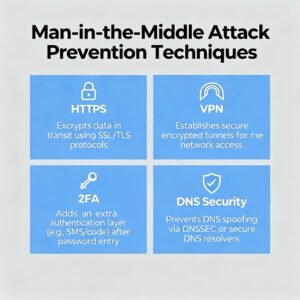Man in the Middle Attacks
Real-World Examples and How to Prevent Them
Introduction
Cyber threats are on the rise, and one attack type that continues to evolve with advancing technology is the Man-in-the-Middle or MITM attack. It’s a silent and deceptive intrusion method where a hacker secretly intercepts and possibly alters communication between two parties who believe they are directly interacting with each other. The terrifying truth about MITM attacks is that they are often invisible until damage is done be it stolen credentials, financial loss, or compromised personal data.

Understanding how these attacks work, learning from real-world incidents, and adopting strong prevention strategies are essential for individuals, businesses, and cybersecurity professionals alike. In this detailed blog, we’ll cover what MITM attacks are, how they happen, the most notable examples from real life, how to recognize them, and, most importantly, how to protect against them effectively.
What is a Man in the Middle Attack?
A Man-in-the-Middle (MITM) attack is a cybersecurity breach where an attacker secretly intercepts and possibly manipulates communication between a sender and receiver. The hacker positions themselves in the “middle,” enabling them to read, modify, or inject false information without either party realizing that someone else is eavesdropping.
The interaction can involve emails, websites, Wi-Fi connections, or even browser activity. For example, imagine you log in to your bank’s website using unsecured Wi-Fi at a coffee shop. A hacker on that same network could intercept your login credentials before they reach the bank’s servers, giving them access to your account.
How a MITM Attack Works
To understand this fully, it helps to break down the process into simplified steps that typically occur in sequence.
-
Interception Stage – The attacker gains access to a network or communication channel between two parties. This could involve compromising a Wi-Fi network, spoofing an IP address, or injecting malicious code into a browser session.
-
Decryption or Manipulation – Once the attacker has access, they either decrypt encrypted data or manipulate the content in transit. In many cases, the attacker sets up a fake website resembling the original one to trick users into revealing credentials.
-
Data Theft or Alteration – The attacker can now capture login details, financial data, and confidential messages. In corporate networks, attackers may alter communication to redirect funds or gather intelligence.
The most unsettling aspect of MITM attacks is that the victim rarely notices what happened until much later when damage is discovered.

Real-World Examples of MITM Attacks
To fully appreciate the danger of MITM attacks, it helps to study real examples where attackers successfully executed them, often leading to devastating outcomes. Below are some well-known and insightful cases.

1. The Superfish Incident (2015)
In 2015, Lenovo faced heavy criticism after security researchers found that it preinstalled a program called “Superfish” on its consumer laptops. While the software was marketed as a visual shopping tool, it was discovered to be performing dangerous MITM operations on encrypted HTTPS traffic.
The software installed its own certificate authority (CA) in Windows, allowing it to intercept secure web sessions to inject ads into users’ browsing experience. Essentially, it broke the fundamental trust of HTTPS encryption. The exposure meant that attackers could potentially exploit the same vulnerability to inject malware or steal data.
This event became a significant wake-up call for hardware manufacturers and consumers about the risks of preinstalled software compromising secure communication.
2. The Equifax Data Breach (2017)
While Equifax’s well-known breach was primarily due to software vulnerabilities, investigators found MITM-style interception during parts of the exploitation process. Hackers used man-in-the-middle techniques to monitor and extract data traffic, which reportedly included millions of sensitive data points such as Social Security numbers and credit histories.
The lesson: even the largest organizations, with all their security layers, remain vulnerable to MITM attacks when communication channels are not adequately encrypted or authenticated.
3. Wi-Fi Eavesdropping in Public Networks
One of the most frequent modern examples of MITM attacks occurs daily in public Wi-Fi environments. Users connect to open hotspots in airports, coffee shops, or hotels without realizing that cybercriminals can position themselves between the router and the user’s device.
A hacker could easily set up a rogue access point mimicking a legitimate Wi-Fi network. For example, a fake hotspot named “Coffee_WiFi_Free” can lure users into connecting. Once connected, the attacker can read unencrypted data traffic, including login credentials and browsing details.
This method doesn’t require advanced hacking knowledge it is one of the simplest yet most effective ways attackers steal information.
4. SSL Stripping Attacks
SSL stripping is another clever form of MITM attack that manipulates internet protocols. When users connect to websites using HTTP instead of HTTPS, attackers intercept the traffic and downgrade encrypted sessions to unencrypted ones.
A famous example was discovered by cybersecurity expert Moxie Marlinspike, who demonstrated how attackers could transparently remove SSL encryption between a browser and a server, making secure communications appear legitimate but vulnerable.
This type of attack highlights why modern browsers have shifted toward enforcing HTTPS by default.
5. Email Hijacking in Business Transactions
In business environments, MITM attacks often target high-value financial transactions. A common scenario involves attackers intercepting emails between buyers and vendors to alter payment details.
In one actual case, a UK-based energy firm lost nearly $250,000 after a hacker inserted themselves between corporate emails, changing the bank details on invoices. Everything else about the communication looked genuine, so the company unknowingly transferred the funds to the attacker’s account.
Such incidents continue to happen across industries, reminding companies to rely on secure email encryption, digital signatures, and verification protocols.
Common Types of Man-in-the-Middle Attacks
Understanding the various forms MITM attacks can take helps in recognizing and defending against them. These are the most prevalent types seen in real-world scenarios:
-
Wi-Fi Eavesdropping – Attackers intercept unencrypted data on public or fake Wi-Fi networks.
-
IP Spoofing – The attacker disguises themselves as a legitimate IP address to intercept traffic.
-
DNS Spoofing – Attacks redirect users from genuine websites to malicious ones.
-
HTTPS Spoofing – Attackers present fake SSL certificates, making users believe they are on secure websites.
-
Email Hijacking – Intercepting business or personal emails to alter, monitor, or inject fraudulent content.
-
Session Hijacking – Capturing session tokens to impersonate legitimate users and gain access to systems.
-
SSL Stripping – Downgrading HTTPS sessions to HTTP connections to bypass encryption.
Each attack type requires its own defense strategy, but the underlying principle remains the same: controlling and securing your communication channel.
Signs You Might Be Experiencing a MITM Attack
Although MITM attacks are designed to be invisible, several subtle signs can indicate interception is happening.
-
Websites that normally use HTTPS suddenly load as HTTP.
-
Unexpected SSL certificate warnings from browsers.
-
Frequent session timeouts or duplicate login requests.
-
Delayed responses from email servers or applications.
-
Suspicious pop-up requests asking you to re-enter login details.
If any of these signs appear repeatedly, treat them as red flags and investigate immediately, especially on unfamiliar Wi-Fi networks.
How to Prevent Man-in-the-Middle Attacks
Now that we understand how these attacks work, let’s move into actionable prevention strategies. Protection involves a combination of technical safeguards, user awareness, and continuous monitoring.

1. Use HTTPS Everywhere
Always ensure websites you visit are secured with HTTPS, especially when transmitting sensitive information. Modern browsers display a padlock icon for genuine SSL certificates. Avoid submitting credentials or financial data on unencrypted websites.
2. Avoid Public and Unsecured Wi-Fi
Public Wi-Fi networks are hotspots for MITM attacks. Whenever possible, use a personal mobile hotspot instead. If public Wi-Fi is unavoidable, pair it with a VPN (Virtual Private Network) to encrypt all transmitted data.
3. Enable Two-Factor Authentication (2FA)
Even if attackers steal your password, two-factor authentication can block unauthorized access. Use apps such as Google Authenticator or hardware tokens rather than SMS-based codes for better security.
4. Use a Reliable VPN
A VPN encrypts your internet traffic from end to end, creating a secure tunnel that even attackers on the same network cannot decode. Use high-quality VPN services with strong AES-256 encryption.
5. Keep Systems Updated
Operating systems, routers, browsers, and security software should always be up-to-date. Many MITM vulnerabilities arise from outdated or unpatched systems, giving attackers easy entry points.
6. Verify SSL Certificates
When connecting to banking or email websites, verify the certificate details by clicking the padlock icon. Fake or expired SSL certificates can indicate a possible MITM attempt.
7. Use DNS Security Protocols
Adopt secure DNS solutions like DNS over HTTPS (DoH) or DNS over TLS (DoT), which encrypt DNS queries and prevent redirection to fake websites.
8. Train Employees on Cyber Awareness
In corporate settings, human awareness can be the strongest defense. Conduct cybersecurity training to help employees recognize phishing messages, fake Wi-Fi networks, and suspicious redirects.
9. Implement Email Encryption
Use S/MIME or PGP encryption to secure email communication. These protocols ensure that intercepted emails remain unreadable to unauthorized parties.
10. Deploy Network Monitoring Tools
Use intrusion detection systems (IDS) and network monitoring tools like Wireshark to detect anomalies, unusual packet flows, or certificate spoofing attempts in your network.
The Growing Threat of MITM in Mobile Devices
MITM attacks aren’t limited to desktops and corporate environments. Mobile devices, now essential for banking, messaging, and authentication, are increasingly targeted.
Attackers exploit fake mobile apps, rogue access points, and malicious QR codes to intercept communication. Modern mobile-based MITM attacks can even occur through compromised certificate authorities or mobile malware that modifies network settings.
Users should always download apps from trusted stores, regularly monitor app permissions, and avoid scanning QR codes from unverified sources.
Corporate-Level Prevention Strategies
For organizations, especially those handling financial or personal data, MITM prevention must be built into cybersecurity frameworks.
-
Use Network Segmentation – Break down internal networks to minimize the surface area of attacks. Sensitive servers should never share direct communication channels with public-facing services.
-
Implement Strong Certificate Management – Regularly audit SSL certificates, track expiry dates, and ensure they are issued by trusted authorities.
-
Adopt Zero Trust Security Models – Assume every connection, internal or external, may be compromised. Authenticate and encrypt all communications without exception.
-
Enforce Secure VPN and Remote Access Policies – With remote work now common, companies must enforce secure VPN access with MFA enabled.
-
Monitor for Certificate Pinning and Anomalies – Certificate pinning ensures that applications only connect to trusted servers, preventing attackers from substituting fake certificates.
An effective strategy combines technical defense with human vigilance and well-defined incident response protocols.
Emerging Trends and Future of MITM Attacks
MITM attacks continue to evolve with technology. In the coming years, we can expect more sophisticated interception methods integrated with Artificial Intelligence (AI) and machine learning algorithms. Attackers could potentially adapt in real-time to bypass security tools.
Additionally, with the expansion of IoT and smart devices, new attack surfaces are emerging. Compromised IoT cameras, connected TVs, or smart assistants can serve as gateways for MITM operations.
Quantum computing also presents a double-edged scenario it is encryption-breaking capabilities could empower attackers, but new quantum-resistant cryptography could strengthen defenses.
Cybersecurity experts must therefore constantly update their defense frameworks and encryption technologies to keep pace with the attackers’ evolving methodologies.

Final Thoughts
A Man-in-the-Middle attack can happen to anyone individuals, small businesses, or large enterprises. It thrives on the illusion of trust and invisibility, which makes awareness and proactive defense crucial.
The key takeaway is that robust encryption, cautious browsing, proper network hygiene, and awareness go a long way in minimizing risk. Whether you’re connecting to Wi-Fi at home or sending corporate emails, always verify your connections and protect every communication channel possible.
As the cybersecurity landscape advances, users and businesses must never let convenience override security. Every secure connection you establish is one less opportunity for the attacker waiting silently in the middle.
Great insights! I especially liked how you highlighted the real-world risks. Would love to see more examples and articles in the future😊